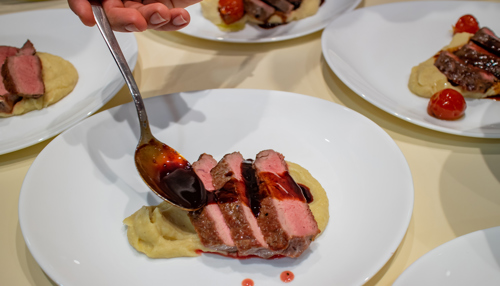Red Wine Sauce Recipe: Perfect Steak Sauce Guide
(0.0) 0 Ratings
Tried the recipe? Rate it!
Ingredients
- 1 Tablespoon(s) Steak Pan Drippings (or butter)
- 1 Tablespoon(s) Garlic minced, or garlic paste
- ¼ Cup(s) Shallot minced
- 1 Cup(s) Red Wine (see wine selection notes below)
- 2 Tablespoon(s) Balsamic Vinegar
- 2 Thyme sprigs, fresh plus extra for garnish
- 1 Cup(s) Beef Stock
- ¼ Cup(s) Fresh Parsley roughly chopped
- 2 Tablespoon(s) Butter
Same-Day Grocery Deliveries Available for New York City
Add all these ingredients to your shopping cart with one click:

Wine Selection Guide
Choose your red wine based on your desired flavor profile:
- Full-bodied wines (Petite Sirah, Syrah, Duoro): Rich, fruity notes of cherry and plum
- Dry wines (Cabernet Sauvignon, Merlot, Malbec): Peppery, warm notes with varying sweetness
- Light-bodied wines (Pinot Noir, Zinfandel): Lighter mouthfeel with diverse flavor profiles

The Ultimate Guide to Making a Red Wine Reduction Sauce
Transform your cooking skills and elevate your next dinner with a classic red wine reduction sauce that will complement any meat dish perfectly. Whether you're preparing a beef tenderloin for a special occasion or looking to enhance the flavor of your favorite steak, this guide will walk you through creating a velvety, aromatic sauce that rivals any high-end restaurant.
Understanding Red Wine Reduction Sauce: A Culinary World Classic
In the culinary world, a red wine reduction sauce is considered one of the most elegant and versatile accompaniments to meat dishes. This concentrated sauce is made by simmering wine until it reduces by half, creating an intense flavor profile that can transform any meal into a gourmet experience. The best part? You can get all the ingredients delivered straight to your door with one click using the green Instacart buttons above.

Best Wines to Use for Your Red Wine Sauce
When making a red wine reduction sauce, selecting the right wine is crucial. Full-bodied red wines like Cabernet Sauvignon, Syrah, or Merlot pair well with rich meat dishes. A good Pinot Noir can also work wonderfully, offering a lighter touch that doesn't overpower the meat. Remember, the wine you choose should be something you'd enjoy drinking – cooking concentrates the flavors, so using a wine you like is essential.
Essential Ingredients That Enhance the Flavor
To make a reduction sauce is to understand the importance of each component. Starting with a quality shallot provides a subtle, sweet foundation that complements the wine perfectly. When you sauté these aromatic ingredients, they caramelize and add depth to your sauce. Fresh herbs like thyme and rosemary contribute an extra touch of sophistication that will elevate your dish.
The Art of Making a Red Wine Reduction
The process begins when you sear your meat in a cast iron skillet or sauté pan over medium heat. Once you've achieved the perfect doneness in your meat, it's time to turn the heat to medium-high and begin the reduction process. The key is to let the wine simmer until it reaches an almost syrupy consistency, which typically happens when the liquid reduces by half from its original volume.
Perfecting Your Technique: From Sauté to Simmer
When you make a reduction, patience is crucial. Start by sautéing your minced shallots until they become translucent and aromatic. Add your choice of red wines like Cabernet Sauvignon or Pinot Noir, and let the mixture simmer on low heat. The goal is to achieve a thick consistency that will beautifully drizzle over your meat.
Creating the Perfect Sauce Pairs for Different Meats
While this sauce pairs wonderfully with beef tenderloin or filet, it's equally delicious with lamb or venison. The concentrated sauce combines perfectly with the rich flavors of braised short ribs or can complement a perfectly cooked steak to your preferred doneness. The internal temperature reaches the ideal point while the sauce reduces, creating a perfect harmony of flavors.
Advanced Tips for a Velvety Finish
To achieve that restaurant-quality finish, consider these professional techniques:
- Add a knob of butter or cold butter at the end to create a silky texture
- Use fresh thyme instead of dried for a more authentic flavor
- Consider adding sautéed mushrooms for an extra layer of complexity
- Taste and adjust the seasoning with black pepper and salt generously
Common Questions About Reduction Sauces
Many home cooks wonder about the best wines to use and how to achieve the right consistency. The key is choosing full-bodied wines and allowing proper time for reducing its volume. Some great choices include Zinfandel, Bordelaise-style wines, or a quality Syrah. The sauce should continue to cook until it reaches a syrupy texture that will perfectly complement your dish.
Mastering the Wine Selection Process
Understanding which wine to use can make or break your sauce. White wine has its place in cooking, but for a classic red wine reduction, stick to red wines like Cabernet Sauvignon, Merlot, or Pinot Noir. These wines enhance the flavor profile of your dish while adding their unique characteristics to the final product.
Advanced Techniques for Professional Results
To truly master this sauce, consider these culinary tips:
- Start with a proper sear in your skillet to develop those rich pan drippings
- Allow the sauce to simmer and concentrate, making a reduction that's full of flavor
- Use medium-high heat initially, then turn the heat down to achieve the perfect consistency
- Add broth or beef stock to build depth
- Finish with fresh herbs to enhance the aromatic profile
How to Pair Your Red Wine Sauce with Different Cuts
Understanding how to pair your sauce with different cuts of meat can make a significant difference in your dining experience. While a red wine reduction sauce pairs perfectly with beef tenderloin, it's also excellent with other cuts. For a classic combination, try it with a perfectly seared filet or use it to complement braised short ribs. The sauce's rich flavor profile can even enhance lamb or venison dishes.
The Role of Aromatics in Your Sauce
Creating a truly remarkable sauce begins with proper aromatic ingredients. Start by adding minced shallots and fresh thyme to your sauté pan. These aromatics caramelize beautifully, adding depth and complexity to your sauce. For an extra touch of sophistication, consider incorporating fresh rosemary or adding sautéed mushrooms to create a more complex flavor profile.
Achieving the Perfect Thick Consistency
One of the most crucial aspects of making a reduction sauce is achieving the right consistency. As you continue to cook the sauce, you'll notice it becoming more concentrated and almost syrupy. The key is to reduce by half while maintaining medium heat. If needed, you can adjust the thickness by adding more beef stock or letting it reduce further until you reach your desired consistency.
Tips for Making a Reduction Sauce Like a Professional Chef
Professional chefs know that the key to a perfect reduction lies in the details. Use a cast iron skillet to develop better flavor, and don't rush the process of reducing its volume. Adding a knob of butter at the end will help create that velvety texture that makes restaurant sauces so memorable. Remember to taste and adjust seasoning generously throughout the cooking process.
Storage and Reheating Tips
Your concentrated sauce can be stored and reheated carefully over low heat. If the consistency becomes too thick, simply add a splash of beef stock or broth to achieve your desired texture. Remember that a good reduction sauce is made to be enjoyed fresh, but proper storage can help preserve its velvety texture and rich taste.
By following these guidelines and using quality ingredients, you'll create a sauce that will elevate any meat dish from good to extraordinary. Remember that practice makes perfect, and each time you make this sauce, you'll develop a better understanding of how to adjust it to your taste preferences.
Whether you're preparing a romantic dinner or hosting a special occasion, this red wine reduction sauce recipe will help you create a memorable dining experience. Don't forget to explore different taste preferences by experimenting with various red wines and complementary herbs to find your perfect combination.
Stomach issues got you down? Check out our in-depth SIBO articles on VivaFreshFood!
SIBO Diet: 28-Day Meal Plan for Small Intestinal Bacterial Overgrowth
The Hydrogen Sulfide Connection: Understanding Your Gut's Secret Gas
The Hidden Dangers of Low Stomach Acid: A Comprehensive Guide to Hypochlorhydria
Methane SIBO Foods to Avoid: Your SIBO Diet Guide
SIBO Symptoms: Understanding Small Intestinal Bacterial Overgrowth & Causes
How to make Red Wine Sauce Recipe: Perfect Steak Sauce Guide
- 01
Heat pan drippings (or butter) in a Cast-Iron Skillet over medium heat. Add garlic and shallots, sautéing until fragrant and tender, about 1 minute. - 02
Pour in the red wine, beef stock, and balsamic vinegar. Add thyme sprigs. Increase heat to medium-high and bring to a rapid simmer. - 03
Let the sauce reduce and thicken, approximately 3-5 minutes. - 04
Remove thyme sprigs. Reduce heat to low and Whisk in the remaining butter until incorporated. - 05
Stir in fresh parsley and adjust seasoning with salt and pepper to taste.
Wine Selection Guide
Choose your red wine based on your desired flavor profile:
- Full-bodied wines (Petite Sirah, Syrah, Duoro): Rich, fruity notes of cherry and plum
- Dry wines (Cabernet Sauvignon, Merlot, Malbec): Peppery, warm notes with varying sweetness
- Light-bodied wines (Pinot Noir, Zinfandel): Lighter mouthfeel with diverse flavor profiles

The Ultimate Guide to Making a Red Wine Reduction Sauce
Transform your cooking skills and elevate your next dinner with a classic red wine reduction sauce that will complement any meat dish perfectly. Whether you're preparing a beef tenderloin for a special occasion or looking to enhance the flavor of your favorite steak, this guide will walk you through creating a velvety, aromatic sauce that rivals any high-end restaurant.
Understanding Red Wine Reduction Sauce: A Culinary World Classic
In the culinary world, a red wine reduction sauce is considered one of the most elegant and versatile accompaniments to meat dishes. This concentrated sauce is made by simmering wine until it reduces by half, creating an intense flavor profile that can transform any meal into a gourmet experience. The best part? You can get all the ingredients delivered straight to your door with one click using the green Instacart buttons above.

Best Wines to Use for Your Red Wine Sauce
When making a red wine reduction sauce, selecting the right wine is crucial. Full-bodied red wines like Cabernet Sauvignon, Syrah, or Merlot pair well with rich meat dishes. A good Pinot Noir can also work wonderfully, offering a lighter touch that doesn't overpower the meat. Remember, the wine you choose should be something you'd enjoy drinking – cooking concentrates the flavors, so using a wine you like is essential.
Essential Ingredients That Enhance the Flavor
To make a reduction sauce is to understand the importance of each component. Starting with a quality shallot provides a subtle, sweet foundation that complements the wine perfectly. When you sauté these aromatic ingredients, they caramelize and add depth to your sauce. Fresh herbs like thyme and rosemary contribute an extra touch of sophistication that will elevate your dish.
The Art of Making a Red Wine Reduction
The process begins when you sear your meat in a cast iron skillet or sauté pan over medium heat. Once you've achieved the perfect doneness in your meat, it's time to turn the heat to medium-high and begin the reduction process. The key is to let the wine simmer until it reaches an almost syrupy consistency, which typically happens when the liquid reduces by half from its original volume.
Perfecting Your Technique: From Sauté to Simmer
When you make a reduction, patience is crucial. Start by sautéing your minced shallots until they become translucent and aromatic. Add your choice of red wines like Cabernet Sauvignon or Pinot Noir, and let the mixture simmer on low heat. The goal is to achieve a thick consistency that will beautifully drizzle over your meat.
Creating the Perfect Sauce Pairs for Different Meats
While this sauce pairs wonderfully with beef tenderloin or filet, it's equally delicious with lamb or venison. The concentrated sauce combines perfectly with the rich flavors of braised short ribs or can complement a perfectly cooked steak to your preferred doneness. The internal temperature reaches the ideal point while the sauce reduces, creating a perfect harmony of flavors.
Advanced Tips for a Velvety Finish
To achieve that restaurant-quality finish, consider these professional techniques:
- Add a knob of butter or cold butter at the end to create a silky texture
- Use fresh thyme instead of dried for a more authentic flavor
- Consider adding sautéed mushrooms for an extra layer of complexity
- Taste and adjust the seasoning with black pepper and salt generously
Common Questions About Reduction Sauces
Many home cooks wonder about the best wines to use and how to achieve the right consistency. The key is choosing full-bodied wines and allowing proper time for reducing its volume. Some great choices include Zinfandel, Bordelaise-style wines, or a quality Syrah. The sauce should continue to cook until it reaches a syrupy texture that will perfectly complement your dish.
Mastering the Wine Selection Process
Understanding which wine to use can make or break your sauce. White wine has its place in cooking, but for a classic red wine reduction, stick to red wines like Cabernet Sauvignon, Merlot, or Pinot Noir. These wines enhance the flavor profile of your dish while adding their unique characteristics to the final product.
Advanced Techniques for Professional Results
To truly master this sauce, consider these culinary tips:
- Start with a proper sear in your skillet to develop those rich pan drippings
- Allow the sauce to simmer and concentrate, making a reduction that's full of flavor
- Use medium-high heat initially, then turn the heat down to achieve the perfect consistency
- Add broth or beef stock to build depth
- Finish with fresh herbs to enhance the aromatic profile
How to Pair Your Red Wine Sauce with Different Cuts
Understanding how to pair your sauce with different cuts of meat can make a significant difference in your dining experience. While a red wine reduction sauce pairs perfectly with beef tenderloin, it's also excellent with other cuts. For a classic combination, try it with a perfectly seared filet or use it to complement braised short ribs. The sauce's rich flavor profile can even enhance lamb or venison dishes.
The Role of Aromatics in Your Sauce
Creating a truly remarkable sauce begins with proper aromatic ingredients. Start by adding minced shallots and fresh thyme to your sauté pan. These aromatics caramelize beautifully, adding depth and complexity to your sauce. For an extra touch of sophistication, consider incorporating fresh rosemary or adding sautéed mushrooms to create a more complex flavor profile.
Achieving the Perfect Thick Consistency
One of the most crucial aspects of making a reduction sauce is achieving the right consistency. As you continue to cook the sauce, you'll notice it becoming more concentrated and almost syrupy. The key is to reduce by half while maintaining medium heat. If needed, you can adjust the thickness by adding more beef stock or letting it reduce further until you reach your desired consistency.
Tips for Making a Reduction Sauce Like a Professional Chef
Professional chefs know that the key to a perfect reduction lies in the details. Use a cast iron skillet to develop better flavor, and don't rush the process of reducing its volume. Adding a knob of butter at the end will help create that velvety texture that makes restaurant sauces so memorable. Remember to taste and adjust seasoning generously throughout the cooking process.
Storage and Reheating Tips
Your concentrated sauce can be stored and reheated carefully over low heat. If the consistency becomes too thick, simply add a splash of beef stock or broth to achieve your desired texture. Remember that a good reduction sauce is made to be enjoyed fresh, but proper storage can help preserve its velvety texture and rich taste.
By following these guidelines and using quality ingredients, you'll create a sauce that will elevate any meat dish from good to extraordinary. Remember that practice makes perfect, and each time you make this sauce, you'll develop a better understanding of how to adjust it to your taste preferences.
Whether you're preparing a romantic dinner or hosting a special occasion, this red wine reduction sauce recipe will help you create a memorable dining experience. Don't forget to explore different taste preferences by experimenting with various red wines and complementary herbs to find your perfect combination.
Stomach issues got you down? Check out our in-depth SIBO articles on VivaFreshFood!
SIBO Diet: 28-Day Meal Plan for Small Intestinal Bacterial Overgrowth
The Hydrogen Sulfide Connection: Understanding Your Gut's Secret Gas
The Hidden Dangers of Low Stomach Acid: A Comprehensive Guide to Hypochlorhydria
Methane SIBO Foods to Avoid: Your SIBO Diet Guide
SIBO Symptoms: Understanding Small Intestinal Bacterial Overgrowth & Causes
- * Delivery times are approximate and subject to Instacart's availability and operational capabilities in your area. VivaFreshFood is not responsible for variations in delivery times.





